Creon Upton – 23 November, 2010
University education is almost too much a meritocracy: its whole economy of production (student work) and outcomes (grades, degrees) is circumscribed neither by the bottom-line imperatives of immediate capital demands and rewards, nor by the less compulsively intentional but perhaps more defining forces of social politics. The entrenched hierarchy of the institution maintains this charming possibility: students remain children, protected from the shameful compromises and eye-averted bullying that comprise the real business of life.
Christchurch
Matt Akehurst, Zhonghao Chen, Oscar Enberg, Sebastian Warne
pig sty / toxic pie
20 November - 26 November, 2010
The 1967 film wasn’t joking. Being a graduate can be a lonely business, and a harbinger of dark times. Egos - inflated yet skeletal, brittle - ascend giddily on shaky beanpoles where they dance about uncertainly - expectant, full of pride, bewildered. Teachers, mentors and friends cast their glances aside, unwilling to involve themselves in the bathetic outcome that experience tells them is, frankly, more than likely.
Strange to say, university education is almost too much a meritocracy: its whole economy of production (student work) and outcomes (grades, degrees) is circumscribed neither by the bottom-line imperatives of immediate capital demands and rewards, nor by the less compulsively intentional but perhaps more defining forces of social politics. The entrenched hierarchy of the institution maintains this charming possibility: students remain children, protected from the shameful compromises and eye-averted bullying that comprise the real business of life.
(While the best student essays are read and marked with the greatest ease, suggesting that the key to student success is to be as invisibly prototypical as possible, in the marketplace that is the key to a life of endless exploitation.)
***
pig sty / toxic pie is an independent show by four male artists at various stages of completion in their Fine Arts studies at Ilam. Refreshingly, the entire show is visible from the footpath. The artists’ contrasting practices mesh well together, and the small space accomodates the works perfectly. At a basic (but important) level, it is the most efficient arrangement of art objects (measured in interest-pleasure per square metre) that you’ll find in Christchurch at the moment, and it’s worth a visit for that alone.
With a dearth of local dealer galleries, the challenges of breaking out of art school and into the art world are particularly palpable here. Artists’ strategic alliances may be becoming more important: the business end of the business thus beckons artist-entrepreneurs willing to risk defilement.
Midway through The Graduate, Benjamin complains to Elaine that since graduating he’s found himself playing a game where the rules make no sense, that they’re made up by all the wrong people. Then he corrects himself: “No, I mean no-one makes them up; they seem to make themselves up.”
These are the ad-hoc rules of a world outside the benevolent micromanagement of undergraduate education. It’s a messy game, and as far as I can tell there’s actually only one rule: those who do best are those who endeavour to live up to their own expectations. Poor Benjamin has no idea whom to obey, so he responds with “this kind of compulsion that I have to be rude all the time.” Many a 21-year-old might relate to that.
But a sense I get of young seekers today is not one of rebellion so much as a kind of uncommitted seriousness: it’s informed, thoughtful and concerned, but it’s extremely reluctant to align itself.
Sebastian Warne has referred to his “cynical view on calamity” informing the type of work he is exhibiting here - a sculptural landscape made of polystyrene and plywood, terraced, branded by a stamp proclaiming corporate ownership, with an overlay of hotglue producing a glacial effect. There’s such an accretion of ideas here that I must credit Warne for his ability to squeeze them all in: a landscape constituted by the refuse of packaging; melting icecaps; traditional terraced farming as an uncanny site for corporate control; land as product, sawn into convenient shape, framed for consumption.
Through this amalgamation of symbols for modern environmental threats, the piece embodies the planet we imagine ourselves living on; as an artwork in this context, then, it puts the earth up for sale to the highest bidder.
Another aspect to this should also be mentioned: no NZer can look at these terraces without thinking “pink and white”. Those buried icons serve a fascinating function as a kind of refuge for colonial regret: their destruction can play the role of our modern nation’s great founding natural disaster because it was - to our endless pleasant surprise - genuinely a natural, not cultural, catastrophe. This plays back into those more general environmental themes, evoking the quick-step we are all guilty of whereby we choose, at our rhetorical convenience, to view humanity as either a part of, or distinct from, the natural world.
These are all good places Warne’s got to I think, but there are problems. It’s both too obvious and too subtle. Somehow the symbolism could use being toned down to allow the conceptual spaces that the work is pointing towards to be arrived at aesthetically rather than analytically.
The work is ridiculously overdetermined - the result of the kind of luxury of thoughtfulness that university allows: I would challenge Warne to smooth his gestures, to allow his work to speak his journey through a gentler rhythm.
And I’d say much the same of Oscar Enberg’s piece: too much, too far, too blatant. The artist has appropriated three digital images of pop star Miley Cyrus as her TV character Hannah Montana; he has defaced these with paint, then printed the results onto pure-white, all-American banners (with tassles), hung these from the wall, affixed metal tubes to Miley’s mouth (benevolently thus obscuring her chipmunk features), and allowed margarine to drip from the tubes onto the gallery floor.
Such careful calculation, but I found myself wishing he’d torn the banners from the wall and left only the margarine. To me, there was a logic to that endpoint that undermined the need for everything else. Perhaps it was the small gallery space and the proximity of other works, but the puddles of slimey yellow junk were enough.
I’m drawing a long bow here, but I couldn’t help but feel that the commercial imperative to offer a product for sale truncated the progress of the art. (None of which is to say that I don’t like the banners: they’re beautiful, just unnecessary - and I concede that as a further consumerist critique that might be yet another top-heavy point the artist is making.)
My criticism is highly specific, but the feeling is a general one: Warne and Enberg are both just coming out of their BFA studies and there lingers about them the drive towards super-saturation. It results from a desire to please, to impress, to over-reference.
I’m not saying that education is bad, or that art school gets it wrong. It doesn’t. But equally it can’t take students all the way.
Perhaps, in fact, postgraduate studies can help. (An early staging post in Benjamin’s Iliad of false consciousness is his decision not to go to grad school.)
Matt Akehurst has finished his Honours year and is contemplating a Masters. He is, I think, a happy apprentice trying to kick himself into undertaking the struggles of the journeyman. Akehurst delights in formal and conceptual intrigues, but he knows that he has to move on. To my mind, his sculpture is a clear statement of that intent. It’s not subtle: a blue blob setting out to destroy the pristine plinth on which it sits.
It was suggested to me that Akehurst is attacking a straw man here - the conservative institution that no longer actually exists. I disagree. The artist is quite deliberately attacking his own inner nemesis - the eternal student who refuses to enter the fray, forever making antagonistic jabs from the sidelines. I find the piece honest, and I like the surprising physicality of the arm that the blob seems to have sprouted just moments before we enter the gallery - at the very point of this amorphous mind’s awakening. The work is a self portrait, showing the artist’s gathering consciousness punching itself in its own brittle sterility. It’s not ashamed to be simple.
And to my mind the strongest works in the show come from Zhonghao Chen, who recently completed his MFA in painting. His compositions are daring, but they’re absolutely captivating once they’ve got a hook into you. I have no idea what he’s on about, but that doesn’t concern me. To the extent that it relates to the consumer-junk theme, he’s made the necessary leap from commentary to context. Junk is merely a condition of his environment and thus simply an inevitable feature of the work: but he’s not trying to tell me how to think about it, and I enjoy that token of respect. He addresses my sensorium, not my cerebrum, and both appreciate the change.
There are still strong signs of the student here, most notably in the extreme painterliness of the works, which incorporate brushstrokes delicate and rude; smears, streaks and decadent, fibrous splodges; as well as untouched canvas, or mere stains or washes of colour.
He’s playing, sure, but he plays his ideas and his practice simultaneously, harmoniously - and that seems like a pretty good place to be.
***
In a (whore) mother and (virgin) daughter, Benjamin the graduate finds equal but opposite post-graduate obsessions, but neither is real. By the end of the film he’s gone nowhere, though he is possibly on the verge of learning something: that passion will only really serve when it’s connected to a place of peace.
An artist must feel at home in the alienation of her work, but it is rare for the young ever to feel at home, so they owe themselves a duty to flow peacefully and patiently, seeking the sounds of silence in the wake of the tumult of their passions.
Creon Upton
Recent Comments
Roger Boyce
"Excitabat enim fluctus in simpulo". - Cicero
Roger Boyce
I'm not sure who Andrew Dean is. I got an email from him proposing we talk - but I've got ...
Andrew Paul Wood
Yes, I thought Andrew Dean's letter a bit odd. Surely the present context art schools are more about creating space ...
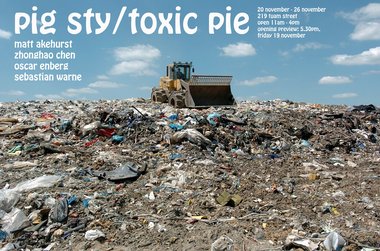

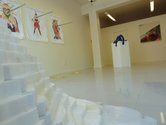
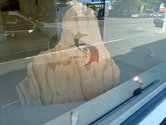
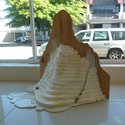
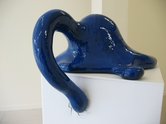


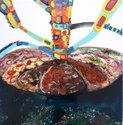
 Two Rooms presents a program of residencies and projects
Two Rooms presents a program of residencies and projects Advertising in this column
Advertising in this column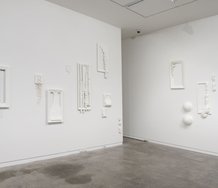
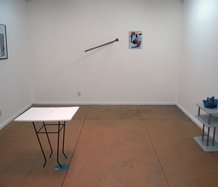
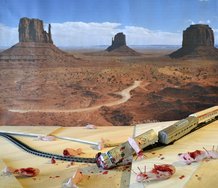
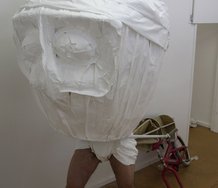
This Discussion has 7 comments.
Comment
Roger Boyce, 12:40 p.m. 25 November, 2010 #
What ever the relative merits of the work in pig sty / toxic pie one has to give it to the kids for organizing a public exhibition in the almost moribund inner precincts of CCH.
Considering the mileage that the Gambia crew have gotten from their long running and scrappy exhibition program, south island youth would be well advised to follw the pig sty/toxic pie / Gambia Castle model.
Now all CCH needs is some actual art collectors rather the endlessly self-recycling civic boosters posing as art patrons that cluster ubiquitously around the CCH 'artworld' but contribute no substantive fertility ($$$) to its ecosystem.
Kudos again to Creon Upton for yet another literate and uber readable bit of criticism. I'd like to think, but don't know for sure, that the toxic pie kids pulled his coat-tail and got him to act as a scribe for their laudable efforts. The kids are alright!
Creon Upton, 10:12 p.m. 25 November, 2010 #
The kids are totally alright.
It was a good opening too: I guess being adjacent to the Atami and Affordable Elegance helped, bringing in a higher class of foot traffic than might otherwise have been expected.
You can't call that neighbourhood moribund! It's the very essence of life as we know it.
Keir Leslie, 12:44 p.m. 5 December, 2010 #
(This has to be of interest here: http://keaandcattle.blogspot.com/2010/12/what-is-happening-at-ilam-open-letter.html)
KL.
Roger Boyce, 10:35 p.m. 7 December, 2010 #
Sigh. Mr.Andrew Dean - whose knuckle-headed open letter is hyper-linked here by Keir Leslie - has an agenda. What that agenda (or Keir Leslie's) might be will likely never see the light of day.....so why should I speculate.
I've never met Mr. Dean. I believe he says he's student affiliated with the English department - I'd suspect, by his tone, he's a close-reader of text rather than a creative writer. He's never introduced himself...or brought to my attention the putative disgruntled student(s) he (supposedly) speaks for. I'd guess one of them might be a girlfriend or boyfriend...?
The gist of his open letter to the school higher-ups is that there is no critical feedback, dialogue, analysis,available to students. His, sans observation, speculation is misty cow-flop.
As a text based academic he thinks, of course, that students should be issued critical hard copy. i.e. lines of text.
I'll make this short and sweet. I presently teach painting at Ilam. I have 40 cumulative years in the art trenches - 20 in NYC. I've been professionally painting and writing art criticism for a good while now.
My (and my painting colleague Robin Neate's) students are taught to paint, think, speak and write critically. Formal and ambulatory (grand rounds - diagnosis, prescription & prognosis) critiques happen EVERY time my painting groups meet - weekly and bi-weekly. Individual critiques happen daily.
Students in painting - by calculated, pedagogical, degree - are taught and acquire the ability to think and publicly speak critically about works of art. To accurately describe, analyze and evaluate.
In this process I'm an active, clarifying participant - if anything, I worry about the possibility of too much feedback, regarding student work, in the course of their acquiring citical skill.
Students in painting know exactly where they stand (we TELL them, in no uncertain terms, on a regular basis - between formal critiques) on any given day.
Mr. Dean, who as far as I know, has never sat in on a critique session in painting knows little to nothing of our process - but, based on juvenile chinese whispers feels qualified to suggest how I go about equipping and qualifying my students for the uber-rigorous vocation of life in the arts.
I suggest that Mr. Dean keep to his critical English theory undertakings - where he's being educationally qualified to write for short-run academic lit-crit journals...read exclusively by other lit-critters.
His theory of what it is we do at SoFA Ilam is just that - theory.And not a very accurate or interesting one at that.
My office door is usually open when classes are in session - if Mr. Dean has the fortitude and character to converse about what it is we actually do - rather than propagate gossip....which is apparently (as far as I can tell ) the life-blood of the Canterbury region.
I'm too occupied to engage with Mr. Dean right now - I'm painting and writing criticism.
Andrew Paul Wood, 2:56 p.m. 9 December, 2010 #
Yes, I thought Andrew Dean's letter a bit odd. Surely the present context art schools are more about creating space and time for the students to develop imprimature, style and experience, rather than some sort of intertextual theoretic.
Judging art is a subjective thing (more so than creative writing even) at best, and the lecturers can only offer the benefit of their experience and knowledge, guiding and advising.
Who is Andrew Dean anyhow? What qualifies him to make these assertions?
Roger Boyce, 6:13 p.m. 9 December, 2010 #
I'm not sure who Andrew Dean is. I got an email from him proposing we talk - but I've got a lot on at the moment and can't afford the aggravation - although when it comes to dialectic aggravation I'm usually your man.
I took a break from painting just now - to eat and apple - and here I am again pissing away my life at a keyboard.
Seems this fellow Dean been hanging around Ilam to the point of Art School 125 protests and thinks that the imposition of bi-yearly ("lengthy") written reports will help the school. Kind of like Martin Luther nailing his 95 theses to the head of schools office door.
Dean knows some, I suppose disgruntled, kids from the program but is loath to say who in particular - but claims to NOT be representing their interests with his open letter.
This has been the year of eternal - externally driven - revolution at SoFA...to the point that one is hard pressed to find time and energy for research and/or teaching.
Well, I knew when I arrived from the U.S. seven years ago that Ilam was too good to be true. An actual art school...of the type that used to get me, as a juvenile delinquent, on the bus to the (pre-theoretcal dictatorship) San Francisco Art Institute - where I and the lead guitar player in my band would moon around the courtyard fountain, in our best On the Road outfits, pretending we were students. The Beatnik art-girls would assiduously ignored us.
Giving Dean the benefit of the doubt. Maybe he's just mooning about Ilam for whatever reason and while he's about the place wants to move the furniture around a bit.
Roger Boyce, 6:43 p.m. 10 December, 2010 #
"Excitabat enim fluctus in simpulo".
- Cicero
Participate
Register to Participate.
Sign in
Sign in to an existing account.